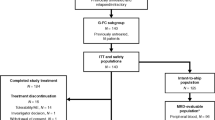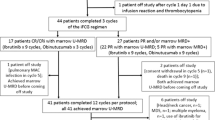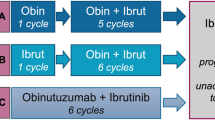Abstract
Cladribine has been reported to have little activity in fludarabine- refractory chronic lymphocytic leukemia (CLL). We sought to determine whether resistance to therapy with cladribine in fludarabine-refractory CLL patients represented primary drug resistance or the inability to tolerate the myelosuppression associated with this therapy. Patients with fludarabine refractory CLL patients without severe thrombocytopenia (platelets ≥50 × 109/l) or granulocytopenia (neutrophils >1.5 × 109/l) were enrolled. All patients received cladribine (0.14 mg/kg) as a 2-h intravenous infusion daily for 5 days, repeated every 4 weeks. Patients received up to six cycles of therapy. Twenty-eight patients enrolled; 13 had intermediate (Rai stage I or II) and 15 high (Rai stage III and IV) risk stages. No patient had a complete remission, but nine (32%; 95% confidence interval, 15–49%) attained a partial remission when assessed using the modified NCI criteria (1996). The median time to relapse for responders was 12 months, while median progression-free survival for the entire group was 9 months (95% confidence interval, 4–14 months). The median overall survival was 2.2 years (95% confidence interval, 0.8–3.1 years). Response was predicted by pre-treatment Rai status with seven of 13 (54%) intermediate risk vs two of 15 (13%) high-risk patients responding (P = 0.04). Toxicity was myelosuppression and infections (grade 3–5: neutropenia 75%, thrombocytopenia 68%, and infections 43%). Cladribine has modest clinical activity and considerable toxicity in a very selected group of patients with fludarabine-refractory CLL lacking pre-treatment neutropenia and thrombocytopenia.
This is a preview of subscription content, access via your institution
Access options
Subscribe to this journal
Receive 12 print issues and online access
$259.00 per year
only $21.58 per issue
Buy this article
- Purchase on Springer Link
- Instant access to full article PDF
Prices may be subject to local taxes which are calculated during checkout



Similar content being viewed by others
References
Rai KR, Sawitsky A, Cronkite EP et al. Clinical staging of chronic lymphocytic leukemia. Blood 1975; 46: 219–234.
Binet JL, Auquier A, Dighiero G et al. A new prognostic classification of chronic lymphocytic leukemia derived from a multivariate survival analysis. Cancer 1981; 48: 198–216.
Grever MR, Kopecky KJ, Coltman CA et al. Fludarabine monophosphate: a potentially useful agent in chronic lymphocytic leukemia. Nouv Rev Fr Hematol 1988; 30: 457–459.
Keating MJ, Kantarjian H, Talpaz M et al. Fludarabine: a new agent with major activity against chronic lymphocytic leukemia. Blood 1989; 74: 19–25.
Piro LD, Carrera CJ, Beutler E et al. 2-Chlorodeoxyadenosine: an effective new agent for the treatment of chronic lymphocytic leukemia. Blood 1988; 72: 1069–1073.
Juliusson G, Liliemark J . High complete remission rate from 2-chloro-2′-deoxyadenosine in previously treated patients with B-cell chronic lymphocytic leukemia: response predicted by rapid decrease of blood lymphocyte count. J Clin Oncol 1993; 11: 679–689.
Tallman MS, Hakimian D, Zanzig C et al. Cladribine in the treatment of relapsed or refractory chronic lymphocytic leukemia. J Clin Oncol 1995; 13: 983–988.
Delannoy A, Ferrant A, Martiat P et al. 2-Chlorodeoxyadenosine therapy in advanced chronic lymphocytic leukaemia. Nouv Rev Fr Hematol 1994; 36: 311–315.
Ho AD, Thaler J, Stryckmans P et al. Pentostatin in refractory chronic lymphocytic leukemia: a phase II trial of the European Organization for Research and Treatment of Cancer. J Natl Cancer Inst 1990; 82: 1416–1420.
Dillman RO, Mick R, McIntyre OR . Pentostatin in chronic lymphocytic leukemia: a phase II trial of Cancer and Leukemia group B. J Clin Oncol 1989; 7: 433–438.
Grever MR, Leiby JM, Kraut EH et al. Low-dose deoxycoformycin in lymphoid malignancy. J Clin Oncol 1985; 3: 1196–1201.
Keating MJ, Kantarjian H, O’Brien S et al. Fludarabine: a new agent with marked cytoreductive activity in untreated chronic lymphocytic leukemia. J Clin Oncol 1991; 9: 44–49.
The French Cooperative Group on CLL, Johnson S, Smith AG et al. Multicentre prospective randomized trial of fludarabine versus cyclophosphamide, doxorubicin, and prednisone (CAP) for treatment of advanced-stage chronic lymphocytic leukemia. Lancet 1996; 347: 1432–1438.
Rai KR, Peterson BL, Appelbaum FR et al. Fludarabine compared with chlorambucil as primary therapy for chronic lymphocytic leukemia. N Engl J Med 2000; 343: 1750–1757.
Leporrier M, Chevret S, Cazin B et al. Randomized comparison of fludarabine, CAP, and ChOP in 938 previously untreated stage B and C chronic lymphocytic leukemia patients. Blood 2001; 98: 2319–2325.
Juliusson G, Elmhorn-Rosenborg A, Liliemark J . Response to 2-chlorodeoxyadenosine in patients with B-cell chronic lymphocytic leukemia resistant to fludarabine. N Engl J Med 1992; 327: 1056–1061.
Saven A, Lemon RH, Piro LD . 2-Chlorodeoxyadenosine for patients with B-cell chronic lymphocytic leukemia resistant to fludarabine. N Engl J Med 1993; 328: 812–813.
Delannoy A, Hanique G, Ferrant A . 2-Chlorodeoxyadenosine for patients with B-cell chronic lymphocytic leukemia resistant to fludarabine. N Engl J Med 1993; 328: 812.
O’Brien S, Kantarjian H, Estey E et al. Lack of effect of 2-chlorodeoxyadenosine therapy in patients with chronic lymphocytic leukemia refractory to fludarabine therapy. N Engl J Med 1994; 330: 319–322.
Cheson BD, Bennett JM, Grever M et al. National Cancer Institute-sponsored working group guidelines for chronic lymphocytic leukemia: revised guidelines for diagnosis and treatment. Blood 1996; 87: 4990–4997.
Genini D, Adachi S, Chao Q et al. Deoxyadenosine analogs induce programmed cell death in chronic lymphocytic leukemia cells by damaging the DNA and by directly affecting the mitochondria. Blood 2000; 96: 3537–3543.
Byrd JC, McGrail LH, Hospenthal DR et al. Herpes virus infections occur frequently following treatment with fludarabine: Results of a prospective natural history study. Br J Haematol 1999; 105: 445–447.
Perkins JG, Flynn JM, Byrd JC . Frequency and type of infections in fludarabine refractory B-cell chronic lymphocytic leukemia and small lymphocytic lymphoma: implications for clinical trials in this patient population. Cancer 2001 (in press).
Cheson BD . Infectious and immunosuppressive complications of purine analog therapy. J Clin Oncol 1995; 13: 2431–2448.
Osterborg A, Dyer MJ, Bunjes D et al. Phase II multicenter study of human CD52 antibody in previously treated chronic lymphocytic leukemia. J Clin Oncol 1997; 15: 1567–1574.
Keating MJ, Byrd JC, Rai KR et al. Multicenter study of campath-1H in patients with chronic lymphocytic leukemia refractory to fludarabine. Blood 1999; 94: 705a (Abstr. 3117).
O’Brien S, Thomas DA, Kantarjian H et al. Rituximab dose-escalation trial in chronic lymphocytic leukemia. J Clin Oncol 2001; 19: 2165–2170.
Byrd JC, Murphy T, Howard R et al. Phase I/II study of thrice weekly rituximab in chronic lymphocytic leukemia/small lymphocytic lymphoma: a feasible and active regimen. J Clin Oncol 2001; 19: 2153–2164.
Chandra J, Niemer I, Gilbreath J et al. Proteasome inhibitors induce apoptosis in glucocorticoid-resistant chronic lymphocytic leukemic lymphocytes. Blood 1998; 92: 4220–4228.
Byrd JC, Shinn C, Ravi R et al. Depsipeptide (FR901228): a novel therapeutic agent with selective, in vitro activity against human B-cell chronic lymphocytic leukemia cells. Blood 1999; 94: 1401–1418.
Byrd JC, Waselenko JK, Keating M et al. Novel therapies for chronic lymphocytic leukemia in the 21st century. Semin Oncol 2000; 27: 587–597.
El Rouby S, Thomas A, Costin D et al. p53 gene mutation in B-cell chronic lymphocytic leukemia is associated with drug resistance and is independent of MDR1/MDR3 gene expression. Blood 1993; 82: 3452–3459.
Cordone I, Masi S, Mauro FR et al. p53 expression in B-cell chronic lymphocytic leukemia: a marker for disease progression and poor prognosis. Blood 1998; 91: 4132–4349.
Dohner H, Stilgenbauer S, James MR et al. 11q deletions identify a new subset of B-cell chronic lymphocytic leukemia characterized by extensive nodal involvement and inferior prognosis. Blood 1997; 89: 2516–2522.
Dohner H, Fischer K, Bentz M et al. p53 gene deletion predicts for poor survival and non-response to therapy with purine analogs in chronic B-cell leukemias. Blood 1995; 85: 1580–1589.
Dohner H, Stilgenbauer S, Benner A et al. Genomic aberrations and survival in chronic lymphocytic leukemia. N Eng J Med 2000; 343: 1910–1916.
Hamblin TJ, Davis Z, Gardiner A et al. Unmutated Ig VH genes are associated with a more aggressive form of chronic lymphocytic leukemia. Blood 1999; 94: 1848–1854.
Damle RN, Wasil T, Fais F et al. Ig V gene mutation status and CD38 expression as novel prognostic indicators in chronic lymphocytic leukemia. Blood 1999; 94: 1840–1847.
Ibrahim S, Keating M, Do KA et al. CD38 expression as an important prognostic factor in B-cell chronic lymphocytic leukemia. Blood 2001; 98: 181–186.
Kitada S, Ajar S, Andersen J et al. Expression of apoptosis-regulating proteins in chronic lymphocytic leukemia: correlations with in vitro and in vivo chemoresponses. Blood 1998; 91: 3379–3389.
Acknowledgements
The research for CALGB 9211 was supported, in part, by grants from the National Cancer Institute (CA31946) to the Cancer and Leukemia Group B (Richard L Schilsky, MD, Chairman), Leukemia and Lymphoma Society of America, The D Warren Brown Foundation, and the Sidney Kimmel Cancer Research Foundation. Its contents are solely the responsibility of the authors and do not necessarily represent the official views of the National Cancer Institute.
The following institutions participated in the study: CALGB Statistical Office, Durham, NC, Stephen George, PhD, supported by CA33601; Dana Farber Cancer Institute, Boston, MA, George P Canellos, MD, supported by CA32291; Duke University Medical Center, Durham, NC, Jeffrey Crawford, MD, supported by CA47577; Mount Sinai School of Medicine, New York, NY, Lewis Silverman, MD, supported by CA04457; North Shore-Long Island Jewish Medical Center, Manhasset, NY, Daniel R Budman, MD, supported by CA35279; Southeast Cancer Control Consortium, Inc, Goldsboro, NC, James N Atkins, MD, supported by CA45808; SUNY Upstate Medical University, Syracuse, NY, Stephen L Graziano, MD, supported by CA21060; Syracuse Hematology-Oncology Assoc. CCOP, Syracuse, NY, Jeffrey Kirshner, MD, supported by CA45389; University of California at San Diego, San Diego, CA, Stephen Seagren, MD, supported by CA11789; University of Chicago Medical Center, Chicago, IL, Gini Fleming, MD, supported by CA41287; University of Iowa, Iowa City, IA, Gerald Clamon, MD, supported by CA47642; University of Maryland Cancer Center, Baltimore, MD, David Van Echo, MD, supported by CA31983; University of Minnesota, Minneapolis, MN, Bruce A Peterson, MD, supported by CA16450; University of North Carolina at Chapel Hill, Chapel Hill, NC, Thomas C Shea, MD, supported by CA47559; University of Tennessee Memphis, Memphis, TN, Harvey B Niell, MD, supported by CA47555; Wake Forest University School of Medicine, Winston-Salem, NC, David D Hurd, MD, supported by CA03927; Washington University School of Medicine, St Louis, MO, Nancy Bartlett, MD, supported by CA77440; Weill Medical College of Cornell University, New York, NY, Michael Schuster, MD, supported by CA07968.
Author information
Authors and Affiliations
Rights and permissions
About this article
Cite this article
Byrd, J., Peterson, B., Piro, L. et al. A phase II study of cladribine treatment for fludarabine refractory B cell chronic lymphocytic leukemia: results from CALGB Study 9211. Leukemia 17, 323–327 (2003). https://doi.org/10.1038/sj.leu.2402752
Received:
Accepted:
Published:
Issue Date:
DOI: https://doi.org/10.1038/sj.leu.2402752
Keywords
This article is cited by
-
A phase I/II study examining pentostatin, chlorambucil, and theophylline in patients with relapsed chronic lymphocytic leukemia and non-Hodgkin’s lymphoma
Annals of Hematology (2006)
-
Apoptotic effect of fludarabine is independent of expression of IAPs in B-cell chronic lymphocytic leukemia
Apoptosis (2006)



